interior lights AUDI Q5 2015 Owners Manual
[x] Cancel search | Manufacturer: AUDI, Model Year: 2015, Model line: Q5, Model: AUDI Q5 2015Pages: 302, PDF Size: 75.01 MB
Page 4 of 302
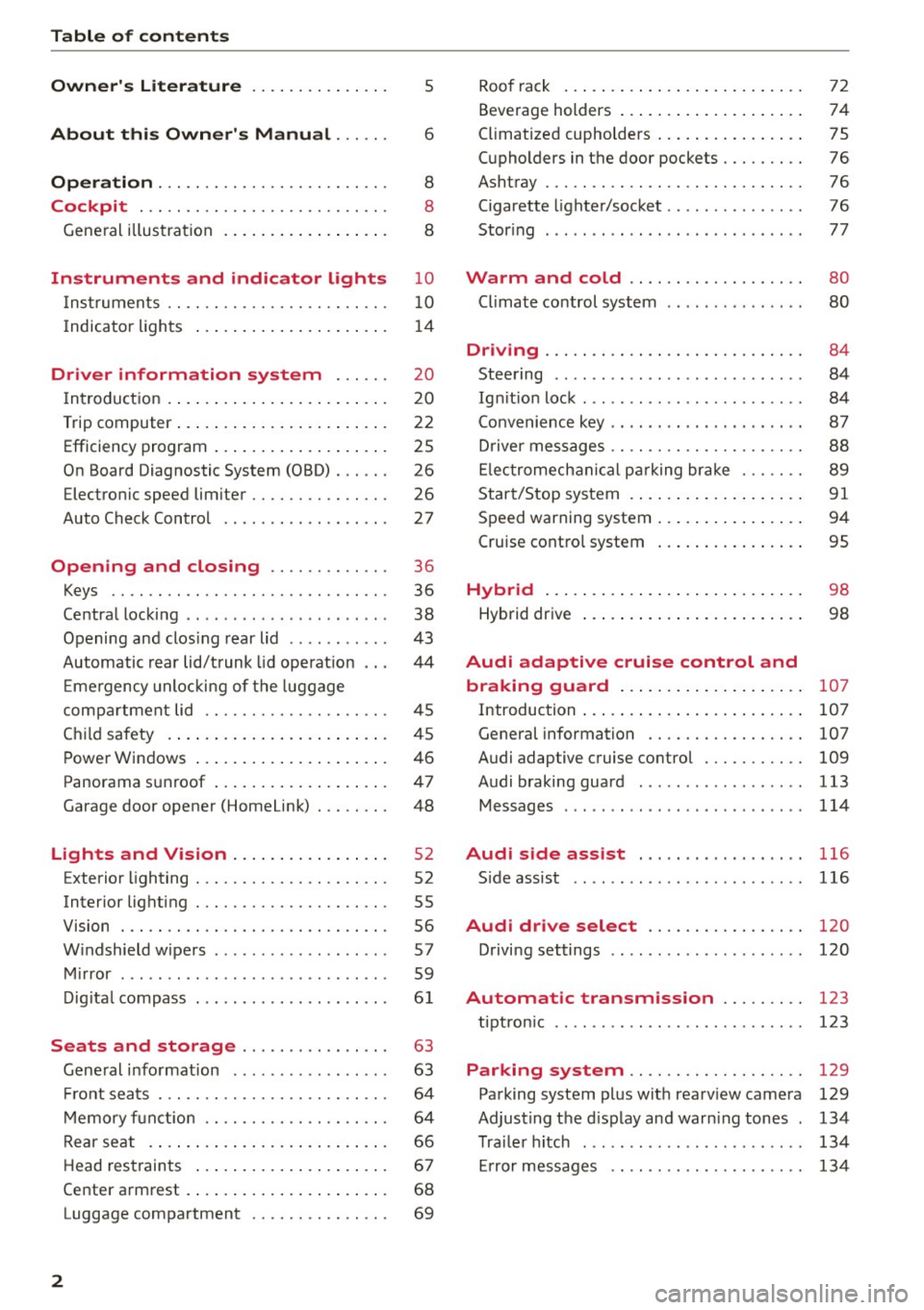
Table of contents
Owner's Literature
About this Owner's Manual ... .. .
Operation ....... ........... .. .. .. .
Cockpit ... .. ...... ......... .. .. .. .
Gene ral illus tra tion . ..... ... .. .. .. .. .
Instruments and indicator lights
Instruments .. .. ...... ..... .. .. .. .. .
I ndicator ligh ts .... ..... ... .. .. .. .. .
Driver information system ... .. .
In troduct ion .... ... ..... ... .. .. .. .. .
Trip computer ... ... ..... ... .. .. .. .. .
Efficiency program .. ..... ... .. .. .. .. .
On Board Diagnostic System (OBD) . .. .. .
Electronic speed lim it er ........ .. .. .. .
Auto Check Control ... ...... .. .. .. .. .
Open ing and closing ...... .. .. .. .
Keys .. .. .. .. .. ............. .. .. .. .
Ce ntra l locki ng .. ... .. ... ..... .. .. .. .
Opening and clos ing rear lid ........ .. .
5
6
8
8
8
10
10
1 4
20
20
22
25
26
26
27
36
36
38
4 3
Automatic rear lid/t runk lid ope rat ion 44
E me rgency unlocki ng of the luggage
compa rtmen t lid . . . . . . . . . . . . . . . . . . . . 45
Ch ild safety . . . . . . . . . . . . . . . . . . . . . . . . 45
P owe r Windows . . . . . . . . . . . . . . . . . . . . . 46
Panorama s un roof . . . . . . . . . . . . . . . . . . .
47
Garage doo r opener (Homelink) . . . . . . . . 48
Lights and Vision . . . . . . . . . . . . . . . . . 52
E xterior lighting . . . . . . . . . . . . . . . . . . . . . 52
Interior lighting . . . . . . . . . . . . . . . . . . . . . 55
V1s1on . . . . . . . . . . . . . . . . . . . . . . . . . . . . . 56
W indshield wipe rs . . . . . . . . . . . . . . . . . . . 57
Mi rror . . . . . . . . . . . . . . . . . . . . . . . . . . . . . 59
D ig ita l compass . . . . . . . . . . . . . . . . . . . . .
6 1
Seats and storage . . . . . . . . . . . . . . . . 63
Gene ral info rmat ion . . . . . . . . . . . . . . . . . 63
Fr ont sea ts . . . . . . . . . . . . . . . . . . . . . . . . . 64
M emory f unct ion . . . . . . . . . . . . . . . . . . . . 64
Rear seat . . . . . . . . . . . . . . . . . . . . . . . . . . 66
Head res traints . . . . . . . . . . . . . . . . . . . . . 67
Center a rm rest . . . . . . . . . . . . . . . . . . . . . . 68
Luggage compartment . . . . . . . . . . . . . . .
69
2
Roo f rack ... .... .. .. ... . .. .... ... . .
Beverage holders ... .... .. .... ... .. . .
Climatized cupholders ... . ..... ... .. . .
(upholders in the doo r pockets ....... . .
A sh tray ... .. .. .. .. ............... . .
Cigarette lighter/soc ket .............. .
Stor ing ... .. .. .. .. .. .... .... ..... . .
Warm and cold .. ... .. ..... ... .. . .
Cl imate control system ... ... ... ... .. .
Dnv1ng ......... .. ............... . .
Steering ...... .. ... ............. .. .
Ig nition lock . .. ... ................. .
Convenience key .. .. .. ...... ... .. .. . .
D rive r mes sage s .. .. .. ........... .. . .
E lectromech anic al par king br ake ... .. . .
Star t/Stop sys tem .. .... . ..... ... .. . .
Speed warning system ... . ..... ... .. . .
Cruise contro l system .... . .... ... .. . .
Hybrid ... .. .... .. .. ... .. ..... ... . .
Hybrid dr ive ..... .. .... .. .... ... .. . .
72
74
75
76
76
76
77
80
80
84
84
84
87
88 89
91
94
95
98
98
Audi adaptive cruise control and
braking guard . . . . . . . . . . . . . . . . . . . .
107
Introduction . . . . . . . . . . . . . . . . . . . . . . . . 107
General information . . . . . . . . . . . . . . . . . 107
Audi adap tive cruise control . . . . . . . . . . . 109
Audi braking guard . . . . . . . . . . . . . . . . . . 113
Messages . . . . . . . . . . . . . . . . . . . . . . . . . . 114
Audi side assist . . . . . . . . . . . . . . . . . . 116
S ideass ist .. .. .. .. ... .. ... ... ... ... 116
Audi drive select . . . . . . . . . . . . . . . . . 120
D riving settings . . . . . . . . . . . . . . . . . . . . . 120
Automatic transmission . . . . . . . . . 123
tiptron ic . . . . . . . . . . . . . . . . . . . . . . . . . . . 123
Parking system . . . . . . . . . . . . . . . . . . . 129
Parking system plus wit h rearv iew camera 129
Adjus ting the d isplay and warn ing tones . 134
T rai le r hitch . . . . . . . . . . . . . . . . . . . . . . . . 134
Er ror messages . . . . . . . . . . . . . . . . . . . . . 134
Page 57 of 302
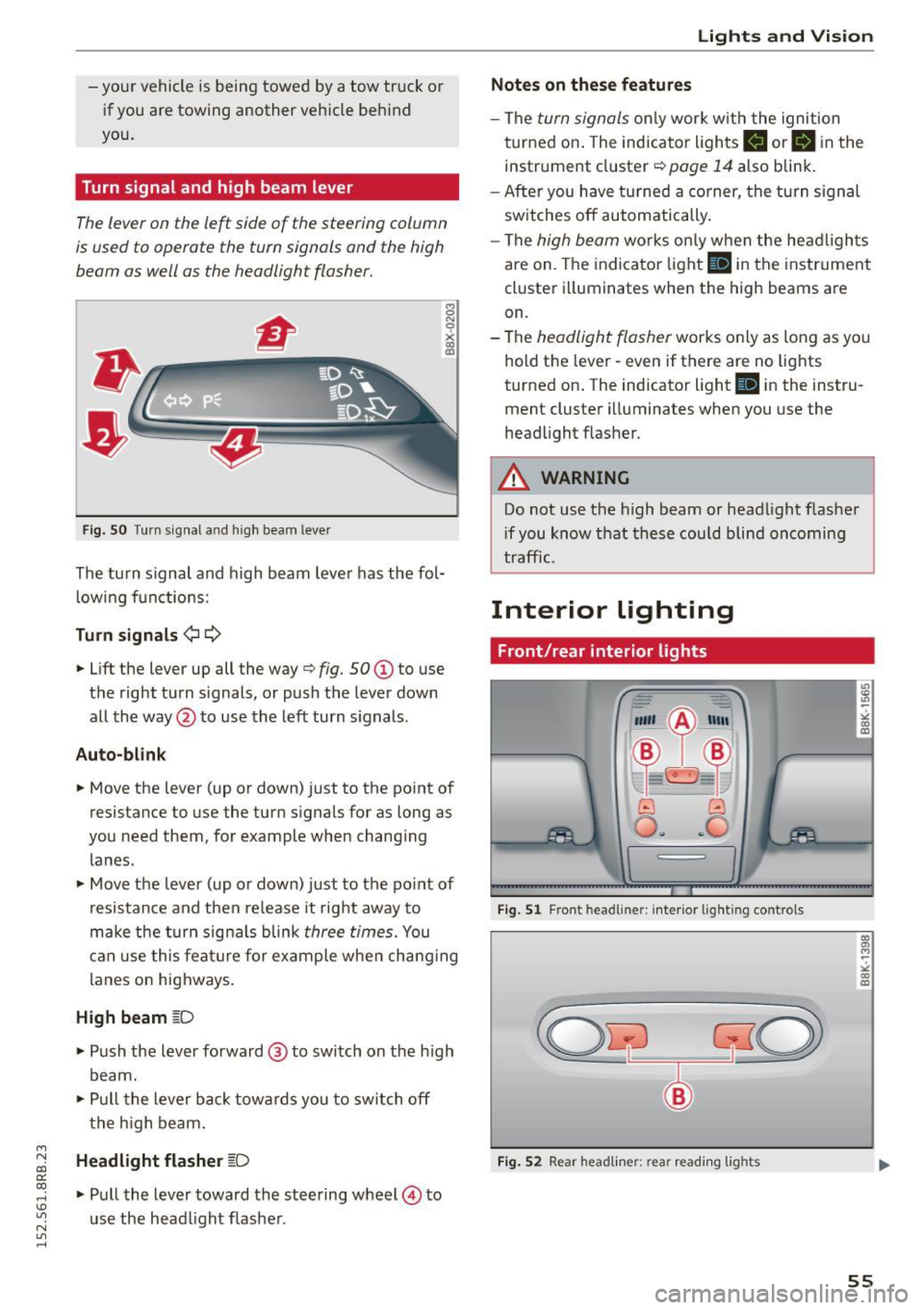
M N
co ~ co
rl I.O
"' N
"' rl
-your vehicle is being towed by a tow truck or
if you are towing another vehicle behind
you.
Turn signal and high beam lever
The lever on the le~ side of the steering column
is used to operate the turn signals and the high
beam as well as the headlight flasher.
Fig. SO Turn s ignal a nd high beam lever
The turn s ignal and high beam lever has the fol·
lowing functions:
Turn signals ¢1 ¢
• Lift the lever up all the way o fig. 50 (D to use
the right turn s ignals, or push the lever down
all the way @to use the left turn signals .
Auto-blink
8 N
0
~ IXI
• Move the lever (up or down) just to the point of
resistance to use the turn signals for as long as
you need them, for example when changing
lanes.
• Move the lever (up or down) just to the point of
resistance and then release it right away to
make the turn signals blink
three times. You
can use this feature for example when changing
lanes on highways.
High beam gD
• Push the lever forward @ to switch on the high
beam.
• Pull the lever back towards you to switch off
the high beam.
Headlight flasher ~D
• Pull the lever toward the steering wheel@ to
use the head light flasher .
Lights and Vision
Notes on these features
-The turn signals only work w ith the ignition
turned on. The indicator lights
II orlll in the
instrument cluster
o page 14 also blink.
- After you have turned a corner, the turn signal
switches off automatically.
- The
high beam works only when the headlights
are on. The indicator light
SI in the instrument
cluster illuminates when the high beams are
on.
- The
headlight flasher works only as long as you
hold the lever· even if there are no lights
turned on. The indicator light
SI in the instru
ment cluster illuminates when you use the
headlight flasher .
A WARNING
-Do not use the high beam or headlight flasher
i f you know that these could blind oncoming
traffic.
Interior lighting
Front/rear interior lights
_. --=:.
I-~~
._ -- v
8 G
o .. .. c
l
Fig. Sl Front headline r: inter ior lighting controls
Fig. S2 Rear headliner : rea r read ing lig h ts
55
Page 58 of 302
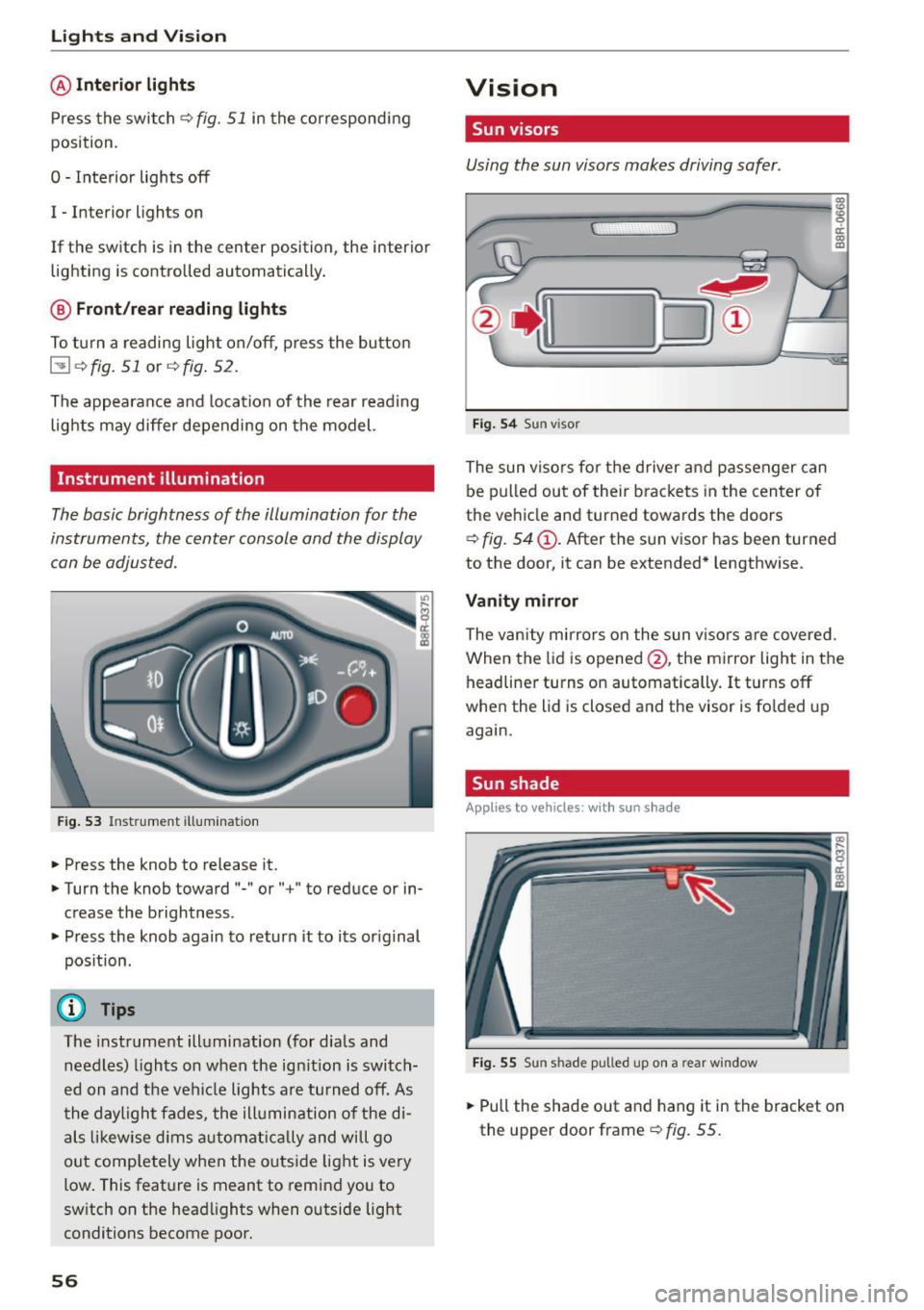
Lights and Vision
@Interior lights
Press the switch¢ fig. 51 in the corresponding
position.
0 -Interior lights off
I -Interio r lights on
If the sw itch is in the center position, the interior
lighting is controlled automatically.
@ Front/rear reading lights
To turn a reading light on/off, press the button
@~ fig. 51 or ¢fig. 52.
The appearance and location of the rear reading
lights may differ depending on the model.
Instrument illumination
The basic brightness of the illumination for the
instruments, the center console and the display
can be adjusted.
Fig. 53 Instrume nt illumina tion
.. Press the knob to release it .
.. Turn the knob toward "-" or"+" to reduce or in
crease the brightness .
.. Press the knob again to return it to its original
position.
(D Tips
The instrument illumination (for dials and
needles) lights on when the ignition is switch
ed on and the vehicle lights are turned off. As
the daylight fades, the illumination of the di
als likewise dims automatically and will go
out completely when the outside light is very
low. This feature is meant to remind you to
switch on the headlights when outside light
conditions become poor.
56
Vision
Sun visors
Using the sun visors makes driving safer .
Fig. 54 Sun visor
The sun visors for the driver and passenger can
be pulled out of their brackets in the center of
the vehicle and turned towards the doors
~ fig. 54 @. After the sun visor has been turned
to the door, it can be extended* lengthwise .
Vanity mirror
The vanity mirrors on the sun visors are covered.
When the lid is opened @, the mirror light in the
headliner turns on automatically.
It turns off
when the lid is closed and the visor is folded up
again.
Sun shade
App lies to vehicles: wi th sun s had e
Fig. 55 Su n sha de pulled up on a rear win dow
.. Pull the shade out and hang it in the bracket on
the upper door frame ~
fig. 55.
Page 63 of 302

M N
co ~ co
rl I.O
"' N
"' rl
-If swallowed and person is conscious, rinse
mouth with water for at least 15 minutes.
Do not induce vomiting unless instructed to
do so by medical professional. Get medical
attent ion immed iately .
(D Note
Liquid electrolyte leaking from broken mirror
glass will damage any plastic surfaces it
comes in contact with . C lean up spilled elec
trolyte immed iately w ith clean water and a
sponge.
@ Tips
- Switching off the dimming function of the
i nside rear view mirror also deactivates the
automat ic dimming function of the exterior
mir rors*.
- The automatic dimming mirrors do not d im
when the interior lighting is turned on or
the reverse gear is selected.
-Automatic dimming for the m irror only op
erates properly if the light striking the in
side mirror is not hindered by other objects.
Digital compass
Activating or deactivating the compass
App lies to vehicles: with dig ital compass
The direction is displayed on the interior rear
view mirror.
Fig. 62 Inside rea r view m irror: digital compa ss activated
.,. To activate or deactivate, hold the@ button
down until the red display appears or disap
pears .
Lights and Vision
The digital compass on ly works with the ignition
turned on. The directions are displayed as initials:
N (North), NE (Northeast), E (East), SE (South
east),
S (South), SW (Southwest), W (West), NW
(Northwest) .
(!_) Tips
To avoid inaccurate directions, do not allow
any remote controls, electrical systems, or
metal parts close to the mirror.
Setting the magnetic deflection zone
Applies to vehicles: wit h dig ita l compass
The correct magnetic deflection zone must be
set in order to display the directions correctly.
®
Fig. 63 North Ame rica: magne tic deflection zo ne bo unda
ri es
.,. Hold the@~ page 61, fig . 62 button down un
til the number of the set magnet ic deflection
zone appears on the inter io r r ear view mirror .
.,. Adjust the magnetic deflection zone by repeat
ed ly pressing on the @button . The set mode
automatically deactivates after a few seconds .
61
Page 64 of 302

Lights and Vi sion
Calibrating the compass
Appl ies to veh icles: w ith digital compass
The compass has to be recalibrated if the display
is wrong or inaccurate .
.,. Hold the@ button down until the letter C is
displayed on the inter ior rear view mirror .
.,. Drive in a circle at a speed of about 6 mph (10
km/h) unt il a direction is shown on the interior
. . rear view mirro r.
A WARNING
The d igital compass is to be use d as a direc
tional a id only. Even though you may want to
look at it whi le you a re dr iving, you mus t still
pay attention to traffic, roa d an d weather con
ditions as well as other possib le hazards .
62
Page 95 of 302
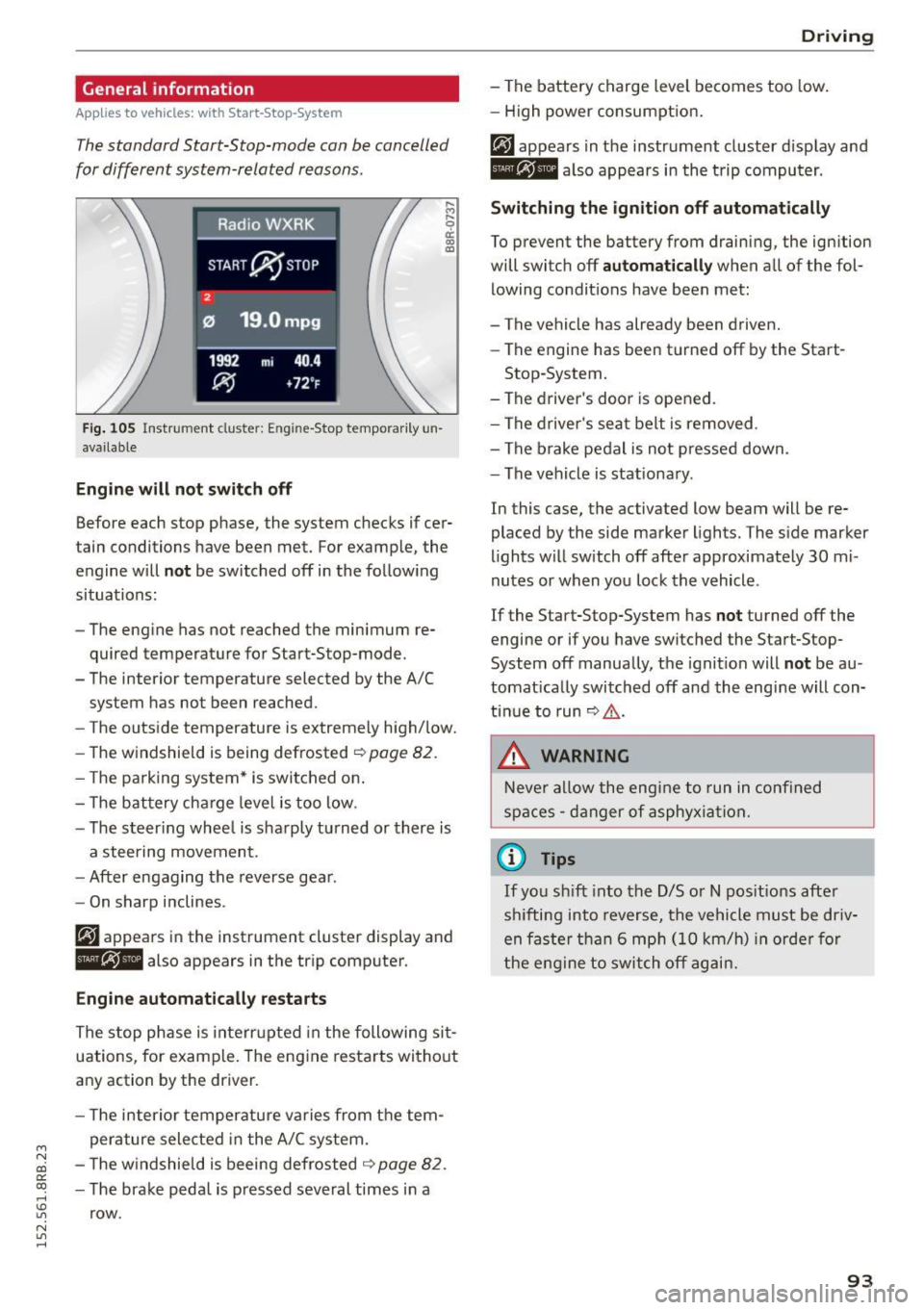
M N
co ~ co
rl I.O
"' N
"' rl
General information
Applies to vehicles: with Start-Stop-System
The standard Start-Stop-mode can be cancelled
for different system-related reasons.
Fig . 105 Instrument cluster: E ngin e-Stop tempo rarily un
available
Engine will not switch off
.... M
9 cc IX) ID
Before each stop phase, the system checks if cer
tain conditions have been met. For example, the
engine will
not be switched off in the following
situations:
- The engine has not reached the minimum re
quired temperature for Start-Stop-mode.
- The interior temperature selected by the A/C system has not been reached.
- The outside temperature is extremely high/low.
- The windshield is being defrosted ~
page 82.
-The park ing system* is switched on .
- The battery cha rge level is too low.
- The steer ing whee l is sharply turned or there is
a steering movement.
- After engaging the reverse gear.
Engine automatically restarts
The stop phase is interrupted in the following sit
uations, for example. The engine restarts without
any action by the driver.
- The interior temperature varies from the tem
perature selected in the A/C system.
- The windshield is beeing defrosted
~ page 82.
-The brake pedal is pressed several times in a
row.
Driving
- The battery charge level becomes too low.
Switching the ignition off automatically
To prevent the battery from draining, the ignition
will switch off
automatically when all of the fol
lowing condit ions have been met:
- The vehicle has already been driven.
- The engine has been turned off by the Start-
Stop-System.
- The driver's door is opened.
- The driver's seat belt is removed .
- The brake pedal is not pressed down.
- The vehicle is stationary .
In this case, the activated low beam will be re
placed by the side marker lights. The side marker
lights will switch off after approximately 30 mi
nutes or when you lock the vehicle .
If the Start-Stop-System has
not turned off the
engine or if you have switched the Start-Stop
System off manually, the ignition will
not be au
tomatically switched off and the engine will con
tinue to run~,&. .
A WARNING
Never allow the engine to run in confined
spaces - danger of asphyxiation.
(D Tips
-
If you shift into the D/S or N positions after
sh ifting into reverse, the vehicle must be driv
en faster than 6 mph (10 km/h) in orde r for
the engine to switch off again.
93
Page 199 of 302
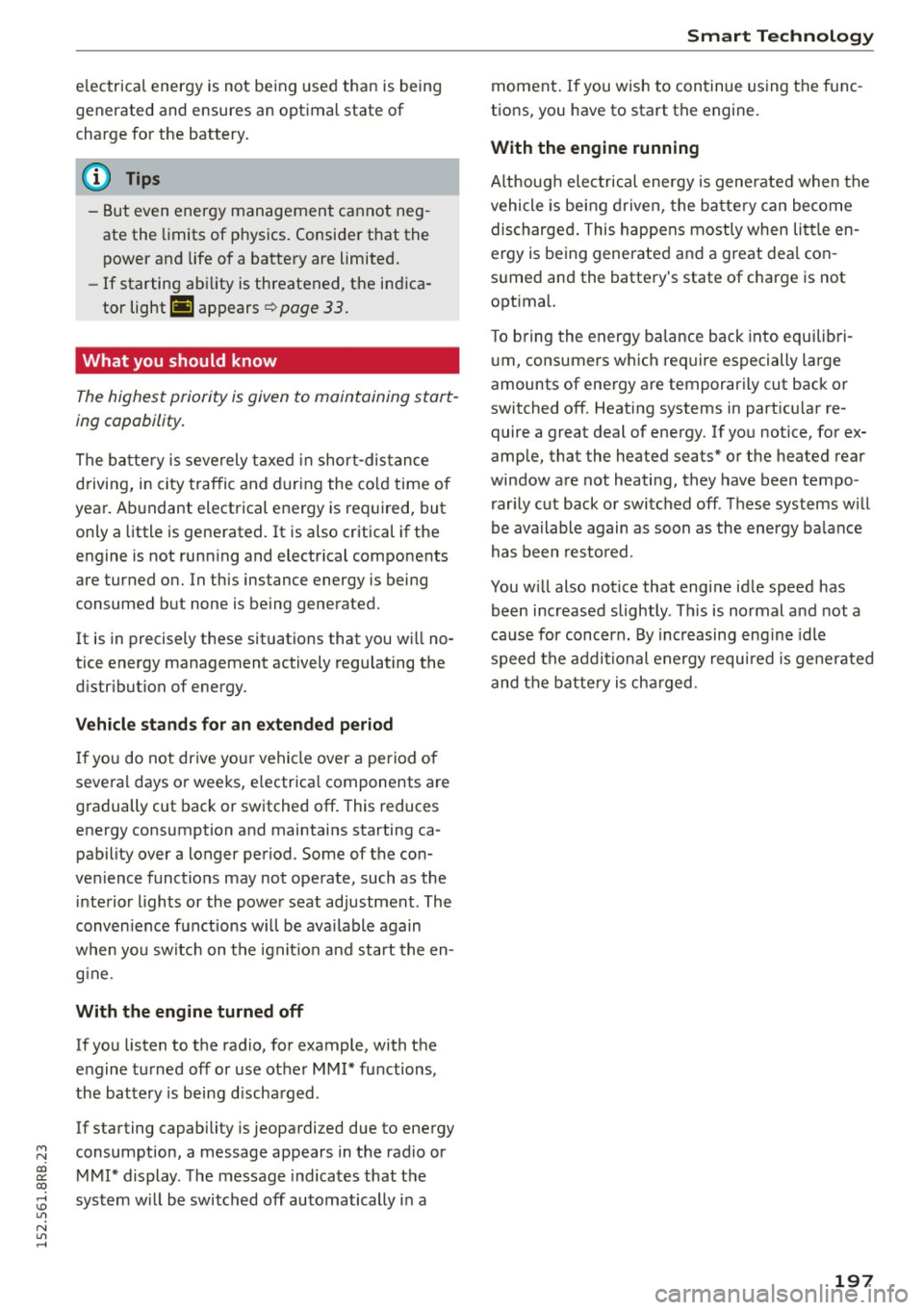
M N
co
a:
co
,...., \!) ..,.,
N ..,., ,....,
electrical energy is not being used than is being
generated and ensures an optimal state of
charge for the battery.
(D Tips
- But even energy management cannot neg
ate the limits of physics. Consider that the power and life of a battery are limited.
- If starting ability is threatened, the indica
tor light (•] appears ~
page 33.
What you should know
The highest priority is given to maintaining start
ing capability.
The battery is severely taxed in short-distance
driving, in city traffic and during the co ld time of
year. Abundant electrical energy is required, but
only a little is generated. It is also critical if the
engine is not running and electrical components
are turned on. In this instance energy is being
consumed but none is being generated.
It is in precisely these situations that you wi ll no
tice energy management actively regulating the
d istribution of energy.
Vehicl e stands fo r an e xte nded p eriod
If you do not drive your vehicle over a period of
several days or weeks , e lectrica l components are
gradually cut back or switched off . This reduces
energy consumption and maintains starting ca
pability over a longer period . Some of the con
ve nience funct ions may not operate, such as the
interior lights or the power seat adjustment. The
conven ience functions wi ll be available again
when you switch on the ignit io n and start the en
g ine.
With the engine turned off
If you listen to the radio, for example, with the
engine turned off or use other MMI* functions ,
the battery is being d ischarged .
If starting capability is jeopardized due to energy
consumption, a message appears in the radio or MMI* display . The message indicates that the
system w ill be switched off automatically in a
Smart T echno log y
moment . If you wish to continue using the func
tions, you have to start the engine.
With the engin e running
Although electrical energy is generated when the
vehicle is be ing driven, the battery can become
discharged . This happens mostly when litt le en
ergy is being generated and a great dea l con
s u med and the batte ry's state of charge is not
opt imal.
T o bring the energy ba lance back into equilibri
u m, consumers which require especially large
amounts of ene rgy are temporarily cut back or
switched off. Heating systems in particu lar re
quire a great deal of energy. If you notice, for ex
amp le, that the heated seats* or the heated rear
window are not heating, they have been tempo
rar ily cut back or switched off . These systems w il l
be available again as soon as the energy ba lance
has been restored.
You w ill also notice that engi ne idle speed has
been increased slightly . T h is is normal and not a
cause for concern. By increasing eng ine idle
speed the additional energy requi red is generated
and the battery is ch arged .
197
Page 233 of 302
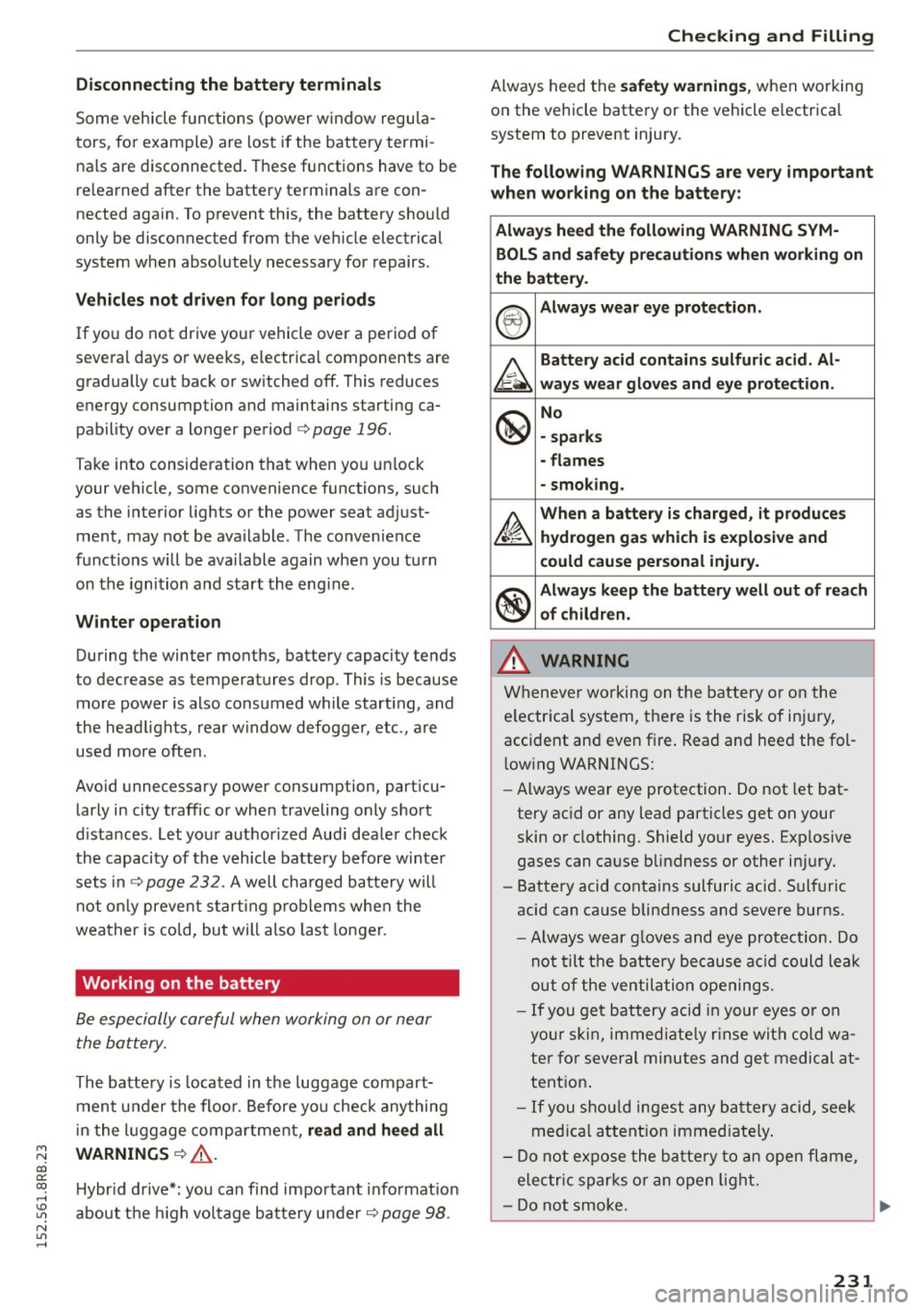
M N
co
a:
co
,...., \!) 1.1'1
N 1.1'1 ,....,
Disconnecting the battery terminals
Some vehicle functions (power window regula
tors , for example) are lost if the battery termi
nals are disconnected. These functions have to be
re learned after th e battery terminals are con
nected again. To prevent this, the batte ry should
only be disconnected from the ve hicle electrical
system when absolutely necessary for repairs.
Vehicles not driven for long periods
If you do not drive your vehicle over a period of
several days or weeks, e lectrica l components are
gradually cut back or switched off. This reduces
energy consumption and maintains starting ca pability over a longer period
c:> page 196.
Take into consideration that when you un lock
your veh icle, some convenience functions, such
as the interior lights or the power seat adjust
ment, may not be available . The convenience
functions will be ava ilable again when you turn
on the ignition and start the engine.
Winter operation
During the winter months, battery capacity tends
to decrease as temperatures drop. This is because
more power is also consumed while starting, and
the headlights, rear window defogger, etc ., are
used more often.
Avoid unnecessary power consumption, part icu
larly in city traffic or when traveling only short
d istances . Let your authorized Aud i dealer check
the capacity of the vehicle battery before w inter
sets in
c:> page 232. A well charged battery will
not only prevent s tarting problems when the
weather is cold, but will also last longer.
Working on the battery
Be especially careful when working on or near
the battery.
The battery is located in the luggage compart
ment under the floor. Before you check anything
in the lug gage compartment,
read and heed all
WARNINGS
c:> ,&. .
Hybr id drive*: you can find important informat ion
about the high vo ltage battery u nder
c:> page 98.
Checking and Filling
Always heed the safety warnings, when working
on the vehicle battery or the vehicle e lectrica l
system to prevent injury.
The following WARNINGS are very important
when working on the battery :
Always heed the following WARNING SYM·
BOLS and safety precautions when working on
the battery.
®
Always wear eye protection.
~
Battery acid contains sulfuric acid. Al·
ways wear gloves and eye protection.
@
No
· sparks
· flames
· smoking.
~
When a battery is charged, it produces
hydrogen gas which is explosive and
could cause personal injury.
®
Always keep the battery well out of reach
of children.
A WARNING
= -Whenever working on the battery or on the
e lectrica l system, there is the risk of injury,
accident and even fire . Read and heed the fol
lo w ing WARNINGS:
- Always wear eye protection. Do not let bat
tery acid or any lead particles get on your
skin or clothing. Shield yo ur eyes. Exp losive
gases can cause blindness or other injury.
- Battery acid contains sulfuric acid. Sulfuric
acid can cause blindness and severe burns .
- Always wear g loves and eye protection. Do
not tilt the battery because acid could leak
out of the ventilation openings.
-If you get battery acid in your eyes or on
your skin, immed iately r ins e with cold wa
ter for several minutes and get medical at
tent ion.
- If you should ingest any battery acid, seek
med ical attention immediate ly .
- Do not expose the battery to an open flame,
elec tric sparks or an open light.
- Do not smoke.
~
231
Page 274 of 302
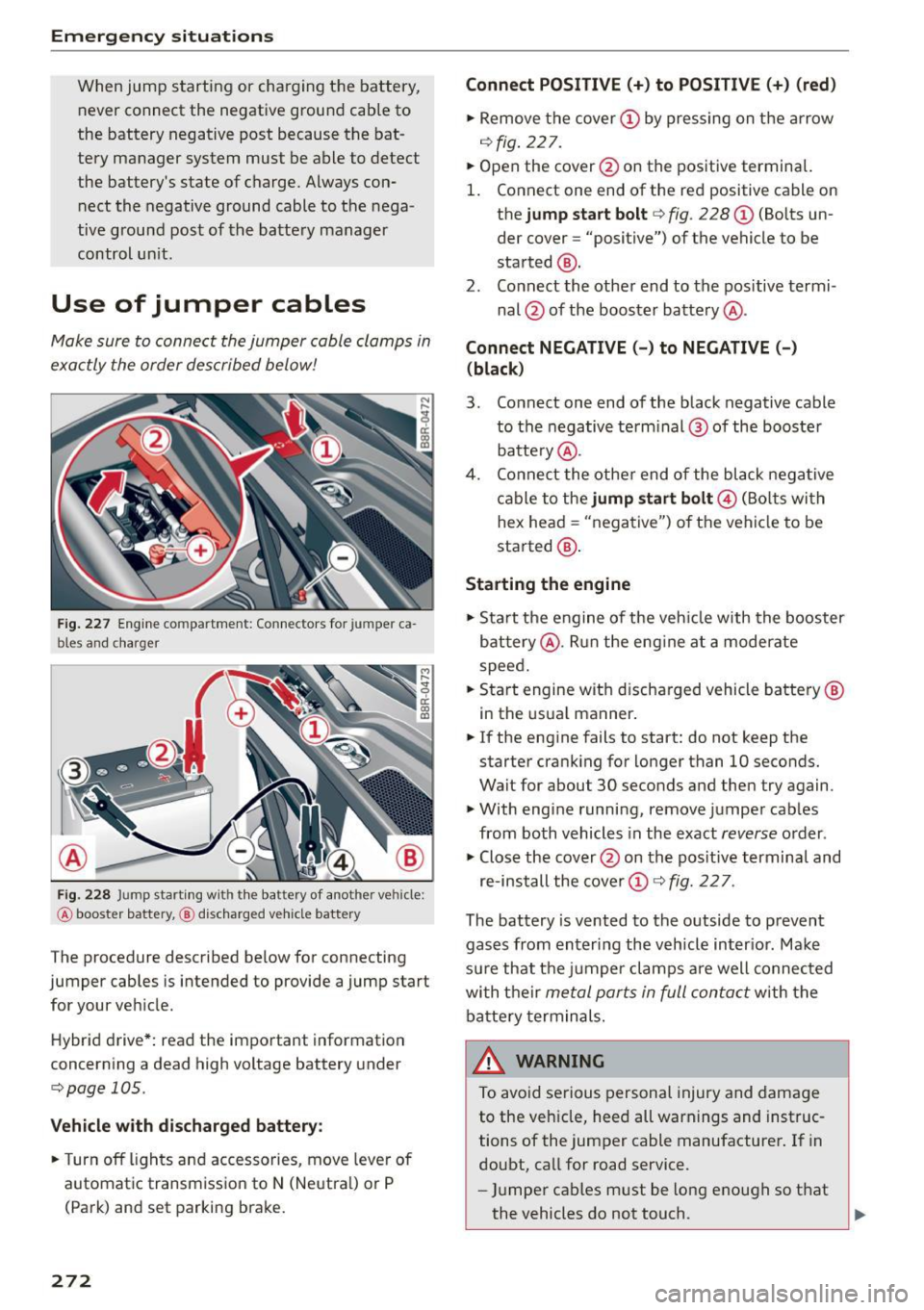
Emergency situation s
When jump starting or charging the battery,
never connect the negative ground cable to
the battery negative post because the bat
tery manager system must be able to detect
the battery's state of charge. Always con nect the negative ground cable to the nega
tive ground post of the battery manager
control un it.
Use of jumper cables
Make sure to connect the jumper cable clamps in
exactly the order described below!
Fig. 227 Engine co mpar tment : Connectors for ju mp er ca
bl es and charger
Fig. 228 Jum p starting wi th the battery of anot her ve hicl e:
@ booste r batte ry ,@ discharged vehicle battery
The procedure described be low for connecting
jumper cables is intended to provide a jump start for your vehicle.
Hybrid drive*: read the important information
concerning a dead high voltage battery under
c;,page 105.
Vehicle with discharged battery:
• Turn off lights and accessories, move lever of
automatic transmission to N (Neutral) or P
(Park) and set parking brake.
272
Connect POSITIVE(+) to POSITIVE (+) (red)
• Remove the cover (!) by pressing on the arrow
¢fig. 227.
• Open the cover @on the positive terminal.
1. Connect one end of the red positive cable on
the
jump start bolt c::> fig. 228 @ (Bolts un
der cover = "positive") of the vehicle to be
started @.
2 . Connect the other end to the positive termi-
nal @ of the booster battery @.
Connect NEGATIVE (-) to NEGATIVE (-)
(black)
3 . Connect one end of the black negative cable
to the negative terminal @ of the booster
battery @.
4. Connect the other end of the black negative
cable to the
jump start bolt © (Bolts with
hex head= "negative") of the vehicle to be
started @.
Starting the engine
• Start the engine of the vehicle with the booster
battery @. Run the eng ine at a moderate
speed.
• Start engine with discharged vehicle battery @
in the usual manner.
• lfthe engine fails to start: do not keep the
starter cranking for longer than 10 seconds.
Wait for about 30 seconds and then try again.
• With engine running, remove jumper cables
from both vehicles in the exact
reverse order .
• Close the cover @on the positive terminal and
re-install the cover@¢
fig. 22 7.
The battery is vented to the outside to prevent
gases from entering the vehicle interior . Make
sure that the jumper clamps are well connected
with their
metal parts in full contact with the
batte ry terminals.
& WARNING
To avoid serious personal injury and damage
to the veh icle, heed all warnings and instruc
tions of the jumper cable manufacturer. If in
doubt, call for road service.
- Jumper cables must be long enough so that
the vehicles do not touch. ..,.
Page 293 of 302

M N
co
a:
co
,...., \!) ..,.,
N ..,., ,....,
Hill descent control . . . . . . . . . . . . . . . . . . . 126
Homelink (garage door opener) . . . . . . . . . . 48
Hood Opening . . . . . . . . . . . . . . . . . . . . . . . . . . . 221
Release lever . . . . . . . . . . . . . . . . . . . . . . . 221
Horn . . . . . . . . . . . . . . . . . . . . . . . . . . . . . . . . . 8
H ow are child restraint system anchors relat-
ed to chi ld safety . . . . . . . . . . . . . . . . . . . . . 184
How many airbags does my vehicle have? . . 158
How safety belt pretensioners work . . . . . . 150
H ybrid drive . . . . . . . . . . . . . . . . . . . . . . . . . . . 98
12 volt batter ies . . . . . . . . . . . . . . . . . . . . 105
Consumption display . . . . . . . . . . . . . . . . . 105
Efficient drive mode . . . . . . . . . . . . . . . . . . 102
Energy flow display . . . . . . . . . . . . . . . . . . 104
EV mode . . . . . . . . . . . . . . . . . . . . . . . . . . . 101
High voltage battery . . . . . . . . . . . . . . 98, 105
High voltage system . . . . . . . . . . . . . . . . . . 98
Operating modes . . . . . . . . . . . . . . . . . . . . 101
Power meter . . . . . . . . . . . . . . . . . . . . . . . . . 99
Starting the vehicle . . . . . . . . . . . . . . . . . . . 99
Transport . . . . . . . . . . . . . . . . . . . . . . . . . . 106
I
Ignition
Sw itch ing on/off . . . . . . . . . . . . . . . . . . . . . 84
Ignition key Emergency unlocking . . . . . . . . . . . . . . . . . . 38
I gnition lock . . . . . . . . . . . . . . . . . . . . . . . . . . 84
Malfunction . . . . . . . . . . . . . . . . . . . . . . 30, 34
Imbalance (wheels) . . . . . . . . . . . . . . . . . . . 243
Important things to do before driving . . . . 135
I mp roperly worn safety be lts. . . . . . . . . . . . 150
Indicator lights . . . . . . . . . . . . . . . . . . . . 14, 100
A irbag system . . . . . . . . . . . . . . . . . . . . . . 162
PASSENGER AIR BAG OFF . . . . . . . . . . . . . 162
Infant seats . . . . . . . . . . . . . . . . . . . . . . . . . 177
Inflatable spare tire . . . . . . . . . . . . . . . . . . . 256
Inflating . . . . . . . . . . . . . . . . . . . . . . . . . . . 257
Inflation pressure (tires) . . . . . . . . . . . . . . . 245
Install ing the upper tether strap on the an
chorage . . . . . . . . . . . . . . . . . . . . . . . . . . . . . 188
I nstrument cluster . . . . . . . . . . . . . . . . . . . . . 99
Indicator lights . . . . . . . . . . . . . . . . . . . . . . 14
Messages . . . . . . . . . . . . . . . . . . . . . . . . . . . 14
I nstrument illum inat ion . . . . . . . . . . . . . . . . 56
Index
Instruments . . . . . . . . . . . . . . . . . . . . . . . . . . 10
Instruments and controls General illustration . . . . . . . . . . . . . . . . . . . . 8
Interior lights
Front. .. .. .. .. .. .... .... .... ... .. .. . 55
Rear . . . . . . . . . . . . . . . . . . . . . . . . . . . . . . . 55
Interval wiping .... ................ ... . 57
Rain sensor . . . . . . . . . . . . . . . . . . . . . . . . . . 57
J
Jump-starting . . . . . . . . . . . . . . . . . . . . . . . . 271
Jumper cables . . . . . . . . . . . . . . . . . . . . . . . . 272
Jump starting 105
K
Key.............. .. ................ .. 36
Battery replacement . . . . . . . . . . . . . . . . . . 37
Check light . . . . . . . . . . . . . . . . . . . . . . . . . . 3 7
Emergency key . . . . . . . . . . . . . . . . . . . . . . . 86
Ignition/eng ine on/off. . . . . . . . . . . . . . . . . 84
Key replacement . . . . . . . . . . . . . . . . . . . . . 36
Master key with remote control . . . . . . . . . 36
Mechan ical key.................. .. . .. 37
Removing . . . . . . . . . . . . . . . . . . . . . . . . . . . 86
Kick-down tiptron ic . . . . . . . . . . . . . . . . . . . . . . . . . . . 127
L
Lane Change Assistant
refer to Side assist . . . . . . . . . . . . . . . . . . . 116
LATCH ......... .. .. .............. ... 184
Description . . . . . . . . . . . . . . . . . . . . . . . . . 185
Installing a child restraint . . . . . . . . . . . . . 186
Location . . . . . . . . . . . . . . . . . . . . . . . . . . . 185
Mounting and releasing the anchorage
hook . . . . . . . . . . . . . . . . . . . . . . . . . . . . . . 186
Latera l ang le . . . . . . . . . . . . . . . . . . . . . . . . . 202
Leather care/cleaning................ .. 211
Left hand drive . . . . . . . . . . . . . . . . . . . . . . . . 54
Lifting jack . . . . . . . . . . . . . . . . . . . . . . . . . . 262
Light Coming home . . . . . . . . . . . . . . . . . . . . . . . . 53
Daytime running lights . . . . . . . . . . . . . . . . 53
Driving light contro l. . . . . . . . . . . . . . . . . . . 52
Emergency flashers . . . . . . . . . . . . . . . . . . . 54
291